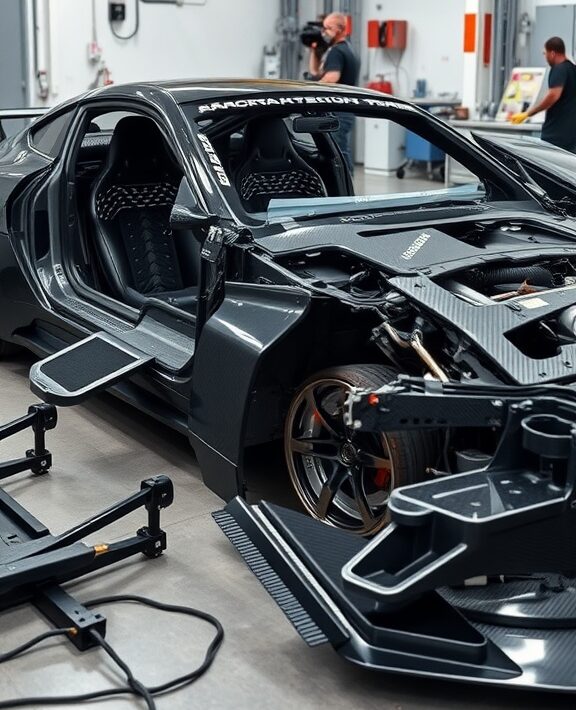High-performance sports cars are all about the thrill of speed, precise handling, and an exhilarating drive experience. With powerful engines and sleek designs, these vehicles offer a unique blend of style and functionality that appeals to car enthusiasts and casual drivers alike. Whether you’re hitting the open road or tackling a track, these cars promise an adrenaline rush with every turn of the wheel.
Performance Testing and Track Records
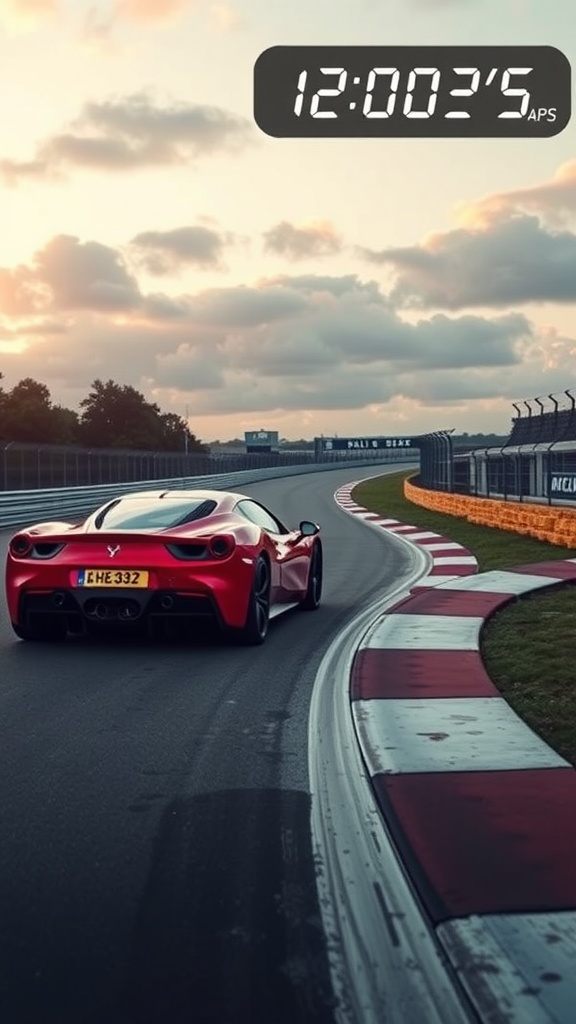
Performance testing is a critical part of evaluating high-performance sports cars. This process helps determine how well a car can handle speed, cornering, and braking on various tracks. The image captures a vibrant red sports car, likely on a racetrack, demonstrating its capabilities as it navigates a sharp turn.
On the track, every second counts. The displayed time of ’12:00:2′ hints at an official lap time, showcasing the car’s speed and agility. Drivers rely on such records to compare performance across different models. Each track presents unique challenges, from tight corners to long straights, putting the car’s engineering to the test.
Every performance test also factors in the driver’s skill. A skilled driver can maximize a car’s potential, contributing to those impressive lap times. It’s a blend of man and machine working in harmony. In this world, every detail matters—from tire selection to aerodynamics, helping push the limits of what’s possible on the track.
Innovative Suspension Systems
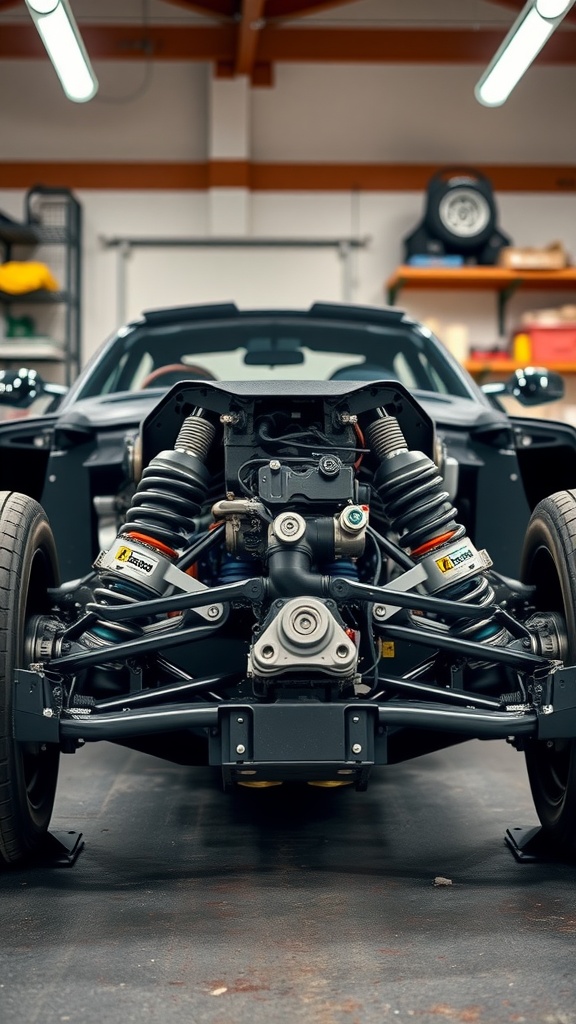
When it comes to high-performance sports cars, the suspension system plays a huge role in how a car handles on the road. The image shows a detailed view of a sophisticated suspension setup. You can see the shock absorbers and springs prominently displayed, designed to provide the best response during high-speed maneuvers.
This system helps the car maintain stability while navigating sharp corners. The design focuses on minimizing body roll, allowing for better grip and control. It’s fascinating how engineers balance comfort with performance, making sure drivers feel connected to the road without sacrificing ride quality.
Many sports cars use adjustable suspension systems that allow drivers to tune the setup for different conditions. Whether it’s a smooth highway or a twisty mountain road, these systems adapt to ensure maximum performance. The image captures this complexity, showcasing how each component works together harmoniously.
Aerodynamic Design Principles

Aerodynamics plays a crucial role in the performance of high-performance sports cars. When you look at a car like the one in the image, you immediately notice its sleek and streamlined shape. This design isn’t just for looks; it’s all about cutting through the air efficiently.
The front of the car is often designed with angles that help direct airflow smoothly over the body. This reduces drag, allowing the car to move faster with less effort. You might also see features like vents and spoilers that manage airflow around the vehicle. These elements create downforce, which helps keep the car stable at high speeds.
Furthermore, the low profile of sports cars contributes to their aerodynamic efficiency. A lower center of gravity means better handling and improved cornering capabilities. When you combine these design features with a powerful engine, you get a car that not only looks stunning but also performs exceptionally on the track.
State-of-the-Art Aerodynamics Features

Aerodynamics plays a key role in the performance of high-performance sports cars. These vehicles are designed to minimize air resistance and maximize stability at high speeds. The sleek lines and contours are not just for looks; they help the car slice through the air more efficiently.
The image shows a powerful sports car making a sharp turn on a winding road. You can see how the rear wing is positioned to generate downforce, allowing the car to grip the road better. This feature is essential for maintaining control during high-speed maneuvers.
Another important aspect is the low profile of the car. A lower stance means less air gets trapped underneath, reducing lift. The carefully designed front splitter and side skirts direct airflow around the vehicle, enhancing stability and performance.
Additionally, materials like carbon fiber are often used in these cars to keep weight down while ensuring strength. This combination allows for quicker acceleration and better handling. So, when you see a high-performance sports car, remember that every detail is crafted for optimal aerodynamics and speed.
Advanced Driver Assistance Systems

Modern high-performance sports cars often come equipped with advanced driver assistance systems (ADAS) that enhance both safety and driving experience. The image showcases a sleek interior of a sports car, highlighting the steering wheel and dashboard filled with tech that assists the driver.
ADAS features include lane departure warnings, adaptive cruise control, and emergency braking, among others. These systems work together to provide a smoother ride. For instance, the lane-keeping assist helps the driver stay centered in their lane, making long drives less tiring.
Another exciting aspect is the integration of cameras and sensors that monitor the surroundings. This technology allows the car to detect obstacles and respond quickly, creating a safer environment on the road. With these systems, drivers can enjoy their cars’ performance while feeling more secure.
Additionally, many sports cars now offer customizable settings for these features. Drivers can adjust the level of assistance to match their comfort and driving style. This personalization makes each journey unique and enjoyable.
High-Performance Tire Technologies
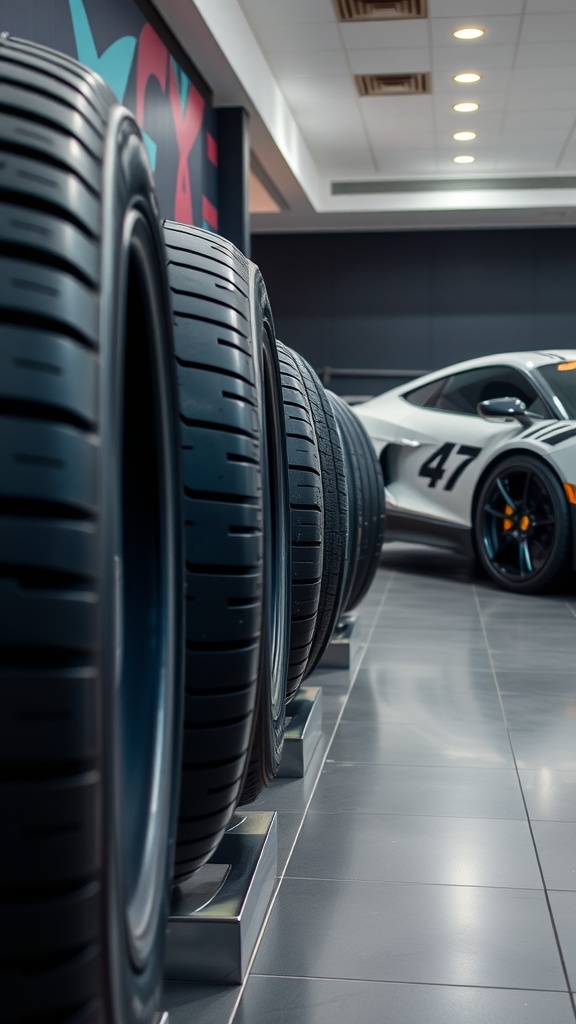
When it comes to high-performance sports cars, the right tires are crucial. The image captures a sleek display of high-performance tires lined up, ready to support thrilling drives. Each tire features unique tread patterns designed for grip and stability, crucial for those sharp turns on the track.
The performance of a sports car relies heavily on its tires. They connect the vehicle to the road and affect everything from handling to speed. The image showcases tires engineered with advanced rubber compounds that enhance traction and reduce wear.
These tires often have a wider profile, which increases surface contact. A wider footprint translates to better grip, allowing drivers to confidently navigate curves. In addition, many high-performance tires are designed to dissipate heat effectively. This feature helps maintain optimal performance, especially during high-speed runs.
Let’s not forget about the role of tire pressure. Maintaining the right tire pressure ensures optimal performance and safety. The visual appeal of the tires in the image also speaks to the craftsmanship involved in their design, marrying aesthetics with functionality.
Lightweight Materials Used in Construction
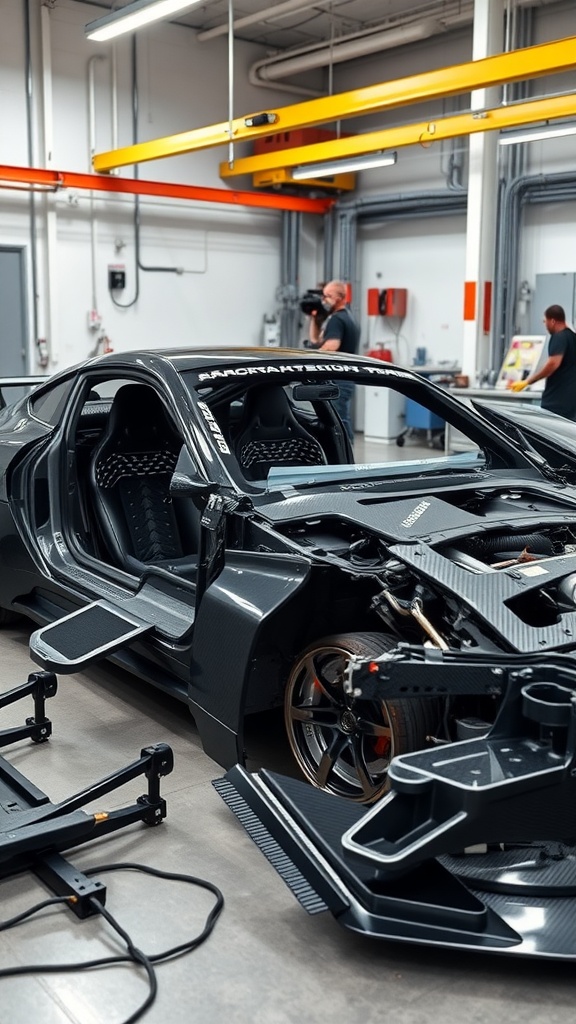
In the world of high-performance sports cars, every detail counts. The image shows a sleek vehicle in the midst of construction, highlighting the use of lightweight materials like carbon fiber. This material is favored for its strength and low weight, making it ideal for enhancing speed and agility.
When engineers design these cars, they focus on reducing weight without sacrificing durability. The carbon fiber panels and components visible in the image are a testament to this effort. They allow for faster acceleration and improved handling, giving drivers an exhilarating experience.
Additionally, the structure of the car indicates careful planning. Elements like the doors and chassis are crafted with precision to ensure they maintain the vehicle’s integrity while being as light as possible. This meticulous approach is what sets high-performance sports cars apart from regular vehicles.
Incorporating lightweight materials not only boosts performance but also contributes to better fuel efficiency. As these cars become more sophisticated, the use of advanced materials continues to evolve, pushing boundaries further in the automotive industry.
Cutting-Edge Engine Technology
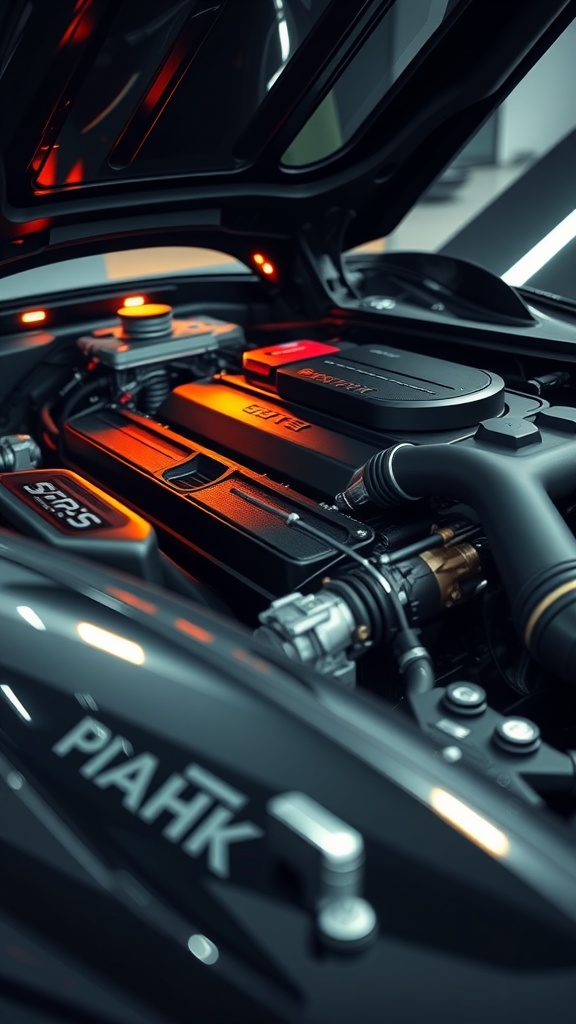
When you pop the hood of a high-performance sports car, what you see is a masterpiece of engineering. The image showcases a beautifully designed engine that’s not just about looks but also performance. You can spot the intricate details that are crucial for delivering power and speed.
The heart of any sports car is its engine, and this one is clearly built with precision. The components are arranged meticulously, allowing for optimal airflow and cooling. This design helps the car achieve remarkable speeds while maintaining stability.
Modern engines often include turbocharging or supercharging, which is evident in the featured model. These technologies force more air into the engine, significantly boosting its power output. It’s not just about raw power; it’s about how efficiently that power is used on the road.
Another highlight is the use of lightweight materials in the engine’s construction. Reducing weight without compromising strength is key to enhancing performance. This engine appears to utilize advanced materials that contribute to a better power-to-weight ratio, making it quicker and more agile.
It’s fascinating to see how technology plays a role in engine tuning. Many manufacturers now offer adjustable features, allowing drivers to fine-tune their driving experience. This adaptability means you can switch from a comfortable ride to a thrilling performance in seconds.
In conclusion, the engine’s design and technology in high-performance sports cars reflect a blend of art and science. Each detail is there for a reason, enhancing the driving experience while pushing the boundaries of speed and efficiency.
Customization and Personalization Options
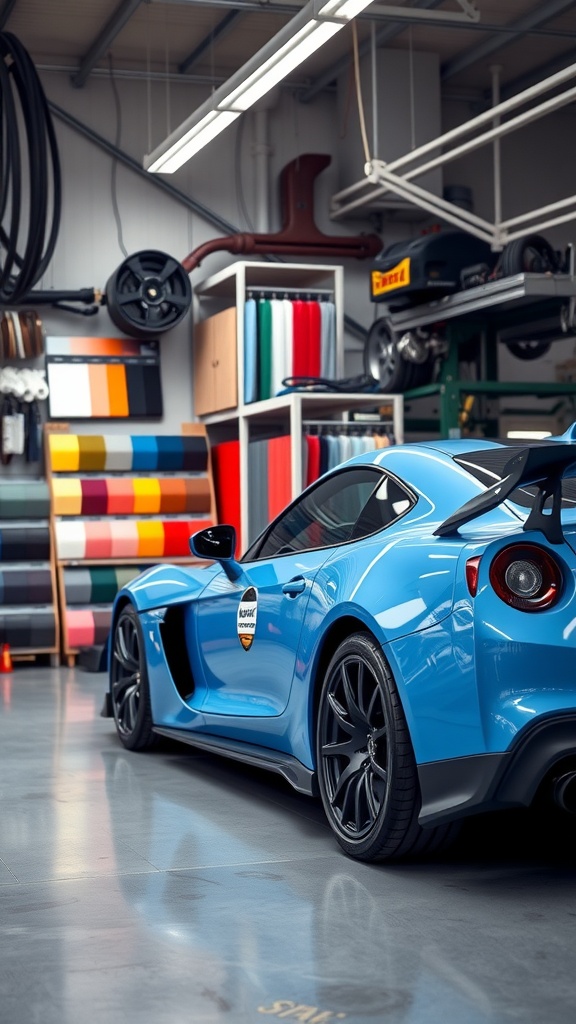
Customization is a key part of the high-performance sports car experience. The image showcases a striking blue sports car in a workshop setting, surrounded by various materials and tools. This car isn’t just about speed; it’s also about making it uniquely yours. From color choices to performance enhancements, the options are almost endless. Many enthusiasts prefer to pick custom colors and finishes, allowing their vehicles to stand out on the road. The bright colors in the background of the image hint at this creative freedom. Another popular area for personalization is the interior. Upgrading to luxury materials, changing the dashboard layout, or adding specific tech features can make a car feel more tailored. You might opt for leather seats in a bold hue or install a custom sound system that perfectly matches your taste. The details matter, and they can take your driving experience to another level. Performance modifications are also quite common. Things like upgraded exhaust systems, enhanced suspension, or even power boosts through tuning can significantly change how your car feels on the road. The beauty of customization is that it reflects your personality and preferences, making your vehicle a true extension of yourself. Whether you’re aiming for aesthetic appeal or performance enhancements, the world of sports car customization invites you to join in the fun!
The Future of Electric Sports Cars

The image captures a sleek electric sports car set against a dazzling city skyline at night. This scene perfectly embodies the essence of modern engineering and urban life. The car’s aerodynamic design hints at speed, while its glowing accents create a striking visual appeal.
Electric sports cars are not just about eco-friendliness; they also deliver thrilling performance. With instant torque and rapid acceleration, these vehicles are changing how we think about speed. Drivers can enjoy the rush of driving without the noise and emissions of traditional engines.
As automakers invest in better battery technology, we can expect longer ranges and quicker charging times. This means more freedom to explore without worrying about running out of charge. The balance between performance and sustainability is becoming more achievable, making electric sports cars a growing choice for enthusiasts.
In the coming years, expect to see even more advancements. Features like autonomous driving and enhanced connectivity will likely become standard. These innovations will provide drivers with a blend of excitement and convenience, allowing for a more enjoyable experience behind the wheel.
